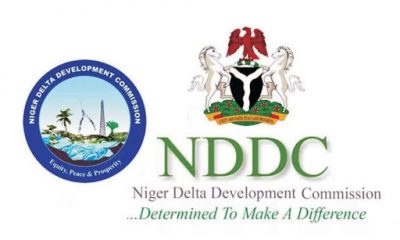Health
HIV/AIDS: Effects, Implication Of Donors’ Exit
Most donor organizations have had issues with lack of accountability in the management of funds by Nigerian officials. This had become a cardinal problem that has short-changed the success of the Nigerian intervention.
Global Fund to Fight AIDS, Tuberculosis and Malaria, for instance, said it has disbursed more than $81.4 billion in Nigeria since 2003. Nigeria, they said, currently represents their largest portfolio with a total of $81.1 billion allocated to fighting HIV/AIDS, TB and Malaria in 2014 to 2016.

There is no doubt
that the contributions of international donor agencies towards the elimination of HIV/AIDS in Nigeria is immeasurable.
In fact, from the point at which donor agencies came on Salvage Mission in Nigeria, they have virtually been vested with the responsibility of providing HIV/AIDS commodities in the country.
Global Fund to Fight AIDS, Tuberculosis and Malaria, for instance, said it has disbursed more than $81.4 billion in Nigeria since 2003. Nigeria, they said, currently represents their largest portfolio with a total of $81.1 billion allocated to fighting HIV/AIDS, TB and Malaria in 2014 to 2016.
On its part, National Agency for the Control of AIDS (NACA) 2012: 59 stated that $300 million was committed in 2007 in expenditure on implementing HIV/AIDS programme in Nigeria.
Of this amount, the majority in the sum of $225,392,257.00 amounting to (85.3%), was from international funds, with bilateral contributions totalling $197,219,307.00, which amounts to (19.43%).
The rest were from International Not-for-Profit organizations and foundations amounting to $32,479 (0.01%).
The same trend was recorded in 2008 with international funds contributing 92.3% of the $364,581,432.00 of the total expenditure.
Meanwhile, $364,581,432.00 (80.8%), $845,477,907,00 (11.5%) and $63,00.00 (0.01%) were respectively contributed by the direct bilateral contributing multilateral agencies and International Non Profit Organizations and Foundations.
Investigations revealed that under the consolidated phase 1 of Rounds 5,8 and 9 Global Fund HIV/AIDS Grant (2009-2012), NACA received about $151.6m for HIV/AIDS activities in the country.
It further gathered that about $228m was later approved for Phase ll (2013-2015) for the scalling up of gender sensitive HIV/AIDS, Prevention, treatment care and support for adult and children including health and community strengthening in Nigeria.
In spite of these and other contributions, in October 2014, the Network of People Living with HIV/AIDs in Nigeria (NEPWHAN), mobilized its members in Abuja to protest at the NACA office over perceived responsiveness of the agency to the dwindling fortunes of the HIV treatment programme in Nigeria.
NEPWHAN’s National Coordinator, Victor Omoshein, had said: “We are concerned with the miserable conditions of PLWHIV in Nigeria, as well as the high number of people dying daily of AIDS related complication in large part to lack of access to Anti-retroviral (ARV) medications as a result of withdrawal support by donor agencies.
Omoshein continued that “only 649,000 out of about 1.8million in need of treatment have access to drugs”. This figure represented about 30 per cent of treatment needs.
The immediate past Director General of NACA, Professor John Idoko had responded then that there were challenges. But he reiterated Government’s Commitment to scalling up from 600,000 to 1.4million. People on treatment, though he did not give a time frame for this ambition.
The real picture of HIV/AIDS response in Nigeria can be seen clearer when it dawns that from inception, funding for Nigeria’s HIV/AIDS intervention has been donor dependent and donor driven as 90 per cent of available funds came from donor agencies.
These agencies get involved in various forms of support ranging from training of personnel, provisions of technical knowhow, supply of life-saving drugs and kits, etc.
Comparatively, the contributions of Nigerian government was mainly reduced to the provision of physical infrastructure, such as provision of health facilities and payment of salaries of medical and other allied personnel employed. The core and major burden of intervention have been borne by the donor agencies.
However, most donor organizations have had issues with lack of accountability in the management of funds by Nigerian officials. This had become a cardinal problem that has short-changed the success of the Nigerian intervention.
The result is that on several occasions, there had been drugs stock-out, which had resulted in truncation of treatment.
There had also been instances where expired drugs were dispensed, as well as fake and substandard testing kits been deployed to counseling and testing centres.
Meanwhile, myriads of PLWHIV lack access to life-saving drugs, while officials have had to destroy valuable supplies due to the expiration of the drugs.
The question that readily comes to mind is, why were these drugs not supplied to those who required them before they got bad.
In Rivers State for instance, FHI 360 is the major provider of HIV/AIDS commodities. The implication is that if FHI 360 seizes to supply these drugs and given that the state government has not given any clear indication to commence the purchase and distribution of HIV/AIDS commodities, the fate of PLWHIV can at best be imagined.
The reason given by donor agencies for their gradual withdrawal include the global financial crisis and changes in their focus of priority, as well as funds available and the allegation of mismanagement of funds by Nigerian officials.
It is notworthy that although these donor agencies have made their intentions to pull out known long ago, nothing concrete seemed to have been done by the Nigerian government in terms of seeking solutions to replace loopholes likely to be warranted by such pull out.
The effect is that when the total pull out is finally implemented and there are not enough remedies, Nigeria’s HIV/AIDS status will be worse than what it is currently.
Beyond the alleged mismanagement of fund meant for HIV prevention, treatment, care and support is a serious lack in policies to ensure smooth running of efforts geared towards checking the HIV/AIDS trend in Nigeria.
The situation is further worsened by the fact that the National Assembly has slashed NACA’s proposed N18.9billion HI V/AIDS budget for the 2016 physical year to N1.5billion.
If donor agencies have invested billions in Dollars to check the trend of HIV/AIDS in Nigeria and the Nigeria government is only willing to invest N1.5billion, the implication smirks of doom.
This is because, if all the billions in dollars could only place Nigeria where it is today in HIV/AIDS, treatment, prevention, care and support, where would N1.5billion place the country. Especially given the present setting of chronic mismanagement of funds?
Sogbeba Dokubo
Health
‘How Micro RNA Research Won Nobel Prize’
Two United States scientists who unraveled the human micro RNA have won the Nobel Prize in Physiology or Medicine 2024.
Victor Ambros and Gary Ruvkun won the coveted prize for their work on microRNA as their discoveries help explain how complex life emerged on earth and how the human body is made up of a wide variety of different tissues.
MicroRNAs influence how genes – the instructions for life – are controlled inside organisms, including humans.
Every cell in the human body contains the same raw genetic information, locked in our DNA.
However, despite starting with the identical genetic information, the cells of the human body are wildly different in form and function.
The electrical impulses of nerve cells are distinct from the rhythmic beating of heart cells. The metabolic powerhouse that is a liver cell is distinct to a kidney cell, which filters urea out of the blood.
The light-sensing abilities of cells in the retina are different in skillset to white blood cells that produce antibodies to fight infection.
So much variety can arise from the same starting material because of gene expression.
The US scientists were the first to discover microRNAs and how they exerted control on how genes are expressed differently in different tissues.
The medicine and physiology prize winners are selected by the Nobel Assembly of Sweden’s Karolinska Institute.
They said: “Their groundbreaking discovery revealed a completely new principle of gene regulation that turned out to be essential for multicellular organisms, including humans.
“It is now known that the human genome codes for over 1,000 microRNAs.”
Health
WHO Begins Regulation On Antibiotic Waste
The World Health Organisation (WHO) has begun acting to curb effects of antibiotic pollution.
The new guidance on wastewater and solid waste management for antibiotic manufacturing sheds light on this important but neglected challenge ahead of the United Nations General Assembly (UNGA) High-Level Meeting on antimicrobial resistance (AMR) taking place on 26 September 2024.
The emergence and spread of AMR caused by antibiotic pollution could undermine the effectiveness of antibiotics globally, including the medicines produced at the manufacturing sites responsible for the pollution.
Despite high antibiotic pollution levels being widely documented, the issue is largely unregulated and quality assurance criteria typically do not address environmental emissions. In addition, once distributed, there is a lack of information provided to consumers on how to dispose of antibiotics when they are not used, for example, when they expire or when a course is finished but there is still antibiotic left over.
“Pharmaceutical waste from antibiotic manufacturing can facilitate the emergence of new drug-resistant bacteria, which can spread globally and threaten our health. Controlling pollution from antibiotic production contributes to keeping these life-saving medicines effective for everyone,” said Dr Yukiko Nakatani, WHO Assistant Director-General for AMR ad interim.
Globally, there is a lack of accessible information on the environmental damage caused by manufacturing of medicines.
“The guidance provides an independent and impartial scientific basis for regulators, procurers, inspectors, and industry themselves to include robust antibiotic pollution control in their standards,” said Dr Maria Neira, Director, Department of Environment, Climate Change and Health, WHO. “Critically, the strong focus on transparency will equip buyers, investors and the general public to make decisions that account for manufacturers’ efforts to control antibiotic pollution.”
Health
Kebbi Harmonises Doctors’ Salaries To Curb Brain Drain
In a concerted effort to curb brain drain, the Kebbi State Government has harmonised medical doctors’ salaries to be at par with their colleagues in the federal government’s tertiary health facilities.
Kebbi State Commissioner for Health, Musa Inusa-Isma’il, disclosed this at the handing over of ambulances to the state-owned health facilities at the Ministry of Health in Birnin Kebbi yesterday.
Inusa Isma’il, according to a statement by Ahmed Idris, the Chief Press Secretary to the governor, said the essence of the harmonisation was to retain the existing medical doctors and attract more to the services of the state.
According to him, the doctors across the state had already started enjoying the new salaries from August 2024.
He said the release of the vehicles was in fulfilment of Governor Nasir Idris’ promise to uplift health care services in the state.
“His Excellency said I should inform you, the beneficiaries of this gesture, that the vehicle should be strictly used for the intended purpose. It should not be used for anything else.
“If there is no referral case, each of the vehicles must be parked at the hospital by 6 pm. The governor said you should warn your drivers against reckless driving as well as violating the instructions.
“We should also do everything possible to reciprocate the gesture by working according to the terms and conditions attached,” he advised.
The benefiting health facilities included Sir Yahaya Memorial Hospital, Birnin Kebbi; State Teaching Hospital, Kalgo; General Hospital, Argungu; General Hospital, Yauri; General Hospital, Zuru; and General Hospital, Bunza.
In his speech, the permanent secretary of the ministry, Dr Shehu Koko, recalled that the ambulances were handed over to the ministry last Friday by the governor for the onward handover to the benefiting hospitals.
He observed that the ambulances would go a long way in improving the referral system in the state, adding that delays in reaching the secondary and tertiary facilities would be eliminated.
The permanent secretary attributed the high rate of maternal mortality in the country to delays in getting to the health facilities for proper medical care.
“We believe with the provision of these ambulances, part of the gaps we have in our referral system will be addressed, whereby patients who require secondary healthcare could be easily transported to secondary and tertiary health centres, where they can get such help,” he said.
In a goodwill message, Commissioner for Information and Culture Alhaji Yakubu Ahmed expressed gratitude to the governor for the support he has given to the ministry to excel.
While advising the beneficiaries to use the vehicles judiciously, the commissioner advised that services and maintenance of the vehicles must be prompt to derive the maximum benefits from the vehicles.
The commissioner also highlighted some achievements recorded by the government in the last year, including beautification of the state capital, completion of a multimillion-naira ultramodern state secretariat, road construction, construction and renovation of classrooms and upgrading of some health facilities, among others.
-
Rivers4 days ago
Don Sues For Leadership Assessment Centre In IAUE
-

 Niger Delta4 days ago
Niger Delta4 days agoOborevwori Boosts Digitalisation With Ulesson 500 Tablets To Pupils, Students
-
Business4 days ago
Cassava Flour Initiative Revival Can Up Economy By ?255b – COMAFAS
-
Sports4 days ago
Eagles B Players Admit Pressure For CHAN Qualification
-

 Niger Delta4 days ago
Niger Delta4 days agoDon Highlights On The Potential Of Groundwater As Hidden Wealth For Sustainable Future
-
Rivers4 days ago
Group Seeks Prosecution Of Clergy, Others Over Attempted Murder
-
Opinion4 days ago
Restoring Order, Delivering Good Governance
-
Business4 days ago
CRG Partner JR Farms To Plant 30m Coffee Seedlings

